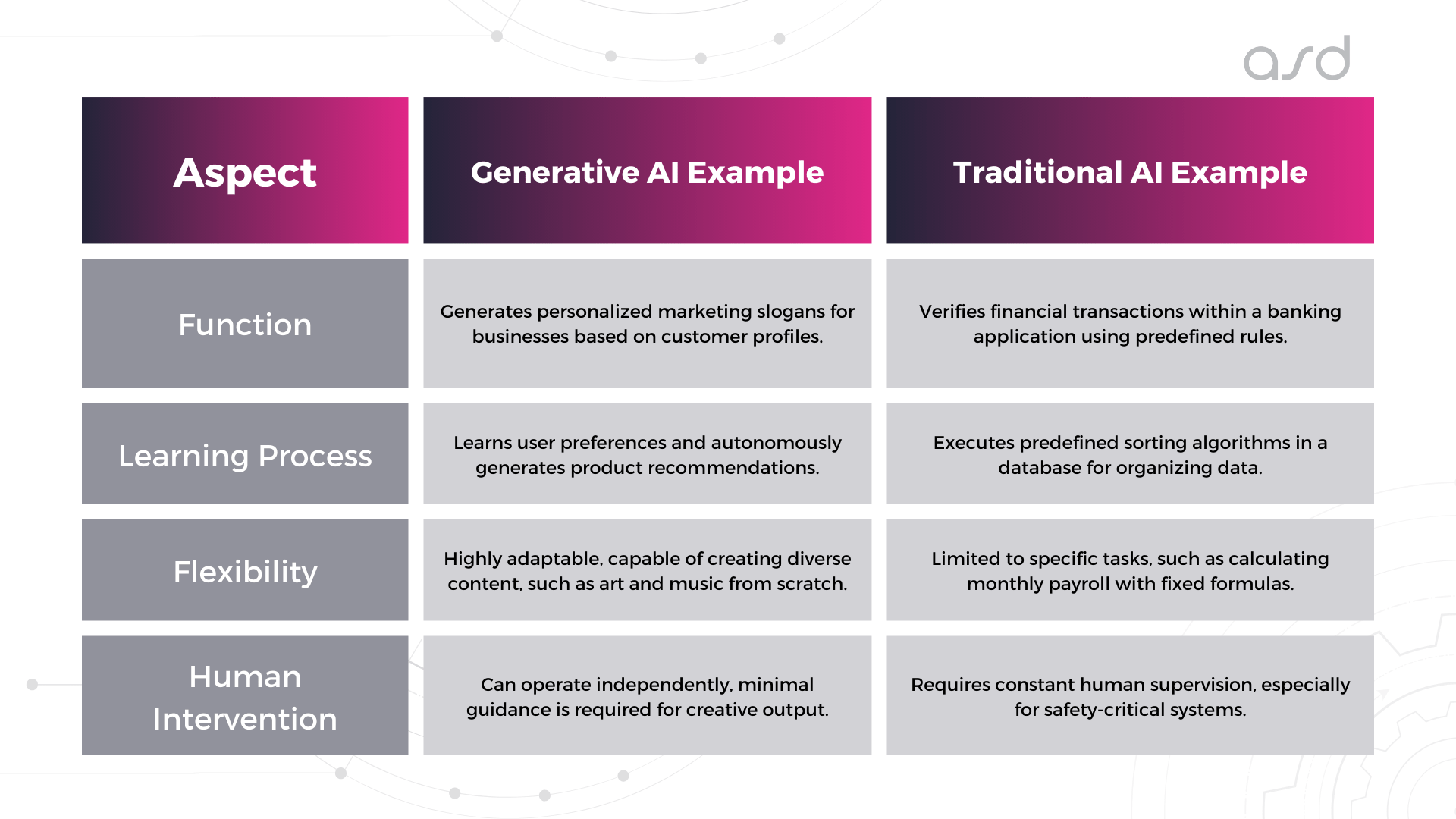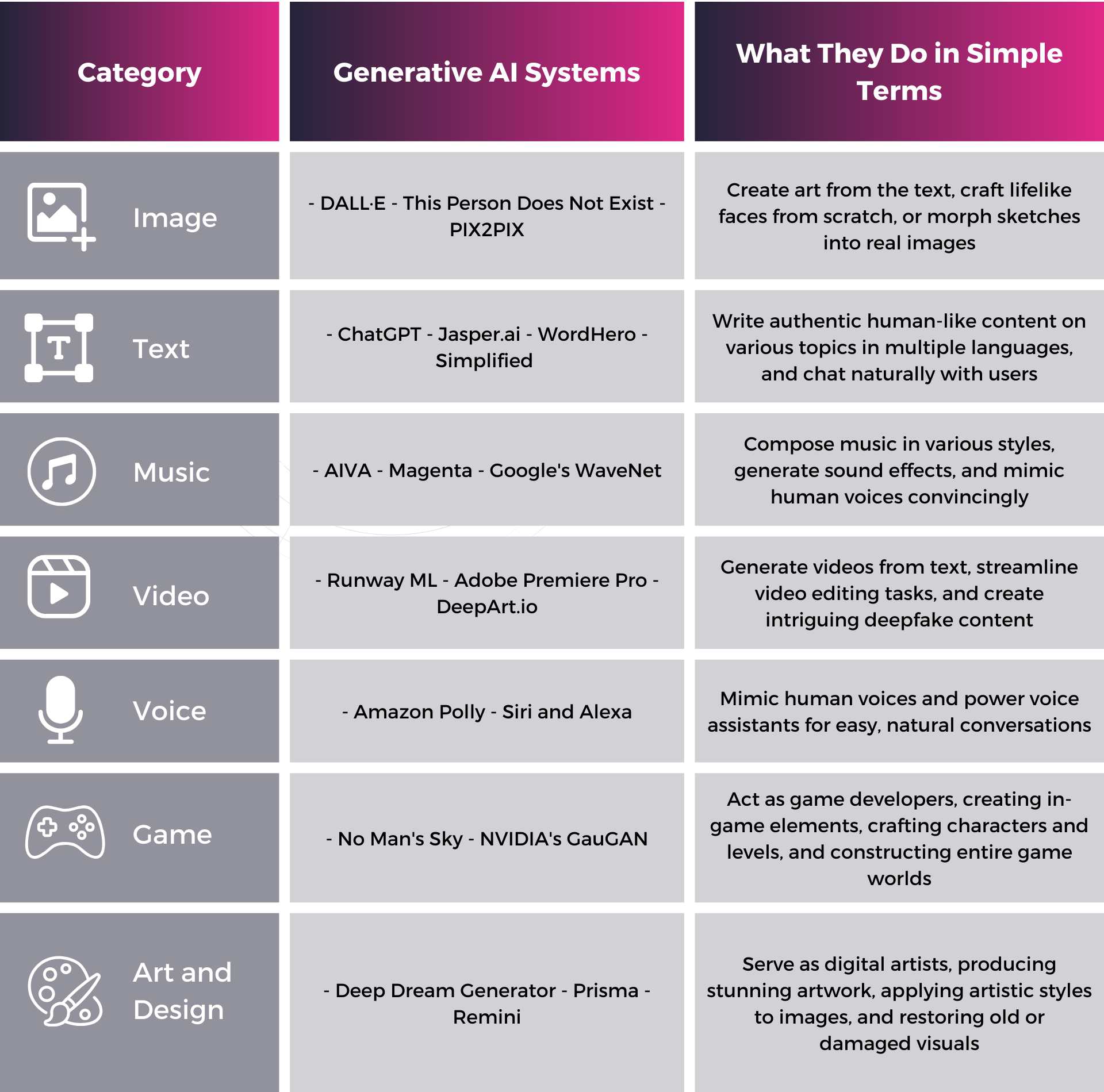What is generative AI, and how does it actually work?
8 minutes read
Once, any mentions of generative AI seemed like something out of this world. Who would have thought it would be a digital reality we live in and utilize for our benefit?
Curiously, generative AI is not a new notion. It began humbly as a chatbot, a rudimentary program designed to engage in text-based conversations. Over time, this type of AI evolved into a sophisticated machine-learning mechanism capable of generating authentic texts, images, and even audio.
However, the introduction of ChatGPT was the tipping point that made it go viral in all industries, and software development is a vivid example. It has made things faster and more efficient as it helps with practically any inquiry if given a good prompt.
Here, we get to know what is a generative AI and discover how it works. As we go about gen AI capabilities, we will also introduce you to the best generators out there and provide some examples of implementation of generative AI in development services.
Many people still confuse generative AI and a traditional one, though they are two distinct paradigms. The primary difference lies in that generative AI autonomously generates authentic content. At the same time, traditional AI works on the previously determined mechanisms that don’t bring any innovation into the content but rather perform given tasks. Here are some other distinctions:
Difference between generative and traditional AI with examples.

The traditional AI system is grounded on algorithms that are explicitly programmed before taking a predefined action.
Having said this, another key difference is that it needs less data. As the rule-based applications depend on pre-programmed rules, there isn’t much training that has to be done on big datasets.
Generative AI is like teaching a computer to learn independently without giving it specific instructions. It’s great for handling complex tasks because it figures things out from the data it’s given, rather than being told exactly what to do.
Before we talk about generative AI capabilities, let’s briefly explain how it works.
This type of AI is designed to imitate humans in reasoning and learning. In a nutshell, generative AI is based on algorithms that explain what a computer ought to do. These algorithms process vast volumes of data, identifying trends beneath them and making forecasts.
Suppose you are trying to teach a computer how to identify cats in pictures. You will show millions of cat and non-cat images so the computer looks at these and learns what features, like whiskers or tails, are shared among all the cats but not present among the non-cat ones. The computer then uses this knowledge to decide if any new picture has a cat in it or not.
The same goes for neural networks. This structure of layers and interconnected nodes is part of what a computer or device can learn by processing and communicating. Thus, it mimics your tone of voice, analyzing your previous templates and taking out shared features.
Generative AI is a trained computer that can make decisions the same way any other person does, yet at a much faster speed and with colossal amounts of data.
Various types of generative AI models can be utilized for multiple purposes. We propose to look at some of them to get familiarized with the most popular ones as well as their diverse capabilities.
Generative AI systems and what they do in simple terms.

These AI generative models are just a drop in the ocean. If you search for generative AI tools on the web, you will find yourself lost in the endless list of other types.
In the large pool of various generators, ChatGPT has won its place under the sun thanks to its accessibility. It is an advanced generative AI model that does well in natural language understanding and generation. You can communicate with it as if it were a human, except it knows everything you could imagine. Be it answering questions or generating decently written texts, with a high level of coherency and relevance.
The tool has widely been adopted by IT companies, eliminating the need for manual operations like content plan and description creation, workflow organizing, coding, and others. Did you know ChatGPT has already created several businesses? That’s truly powerful.
In the next section, we are going to discuss how ChatGPT can be of help to the software development industry.
Speed up your development process with AI
Fell free to ask any questions you might have.

Since ChatGPT has made its name as a multipurpose writing assistant, software businesses immediately found ways of its implementation. Many companies take advantage of ChatGPT by connecting it to tools that they already use, like project management boards, customer support, code control, documentation systems, and others.
A survey by ResumeBuilder in February 2023 found that almost half of US business leaders currently use ChatGPT, and around 30% plan to use it in the future.
Your business can also benefit from this generative AI by automating tedious tasks that can easily be done without human involvement.
One of ASD company’s specializations involves integrating ChatGPT for our client’s software products. Our past successful integrations of ChatGPT have left clients satisfied with results, and we are here to offer you the same opportunities. If maximizing efficiency for enhanced customer experience is what you seek for success in your operations, then our ChatGPT for software development services may be a good fit for you. We can integrate ChatGPT into your software to help lift the burden from time-consuming tasks and push your business towards greater flexibility.
Take a look at some of the integrations we did for our clients:
#1
This is one of the latest projects we have been working on recently. Our travel client’s distribution channel allowed property managers to list various housing options on partner websites like hotels, resorts, rentals, and business spaces. Each platform had unique content editing requirements that had to be manually written and proofread by 15 managers. Inspired by their partner’s idea, we combined ChatGPT and software development to solve editing property descriptions according to specific platform rules. This brought down the manual workload from 15 to only 3 individuals – an outstanding manual effort cut of 5x. This integration helped the company to balance their staff resources better and freed up human capacity for more creative tasks driving company profits at the bottom line in the long run.
#2
Among other ChatGPT integrations, we take pride in improving our property client review management system. With the generative AI in place, their clients who are responsible for property management can now easily generate responses to housing reviews on their websites. Not only that, but they can also personalize these responses, altering the tone of voice, adding the name of the reviewer, specifying property details, and generating a closing message. One more great plus is that this integration allows reviews and responses translation that is written in a foreign language, reducing the language barrier between people.
#3
Our collaboration with one of the leading travel companies transformed trip planning. We deployed ChatGPT as an assistant on their platform, streamlining how users plan trips. Users can have conversations with ChatGPT in a natural language way. Users express what they love to do in their travels and get suggestions for nearby places and restaurants accordingly by ChatGPT. For example, if a user says that he loves Italian food and visiting historical sites, then ChatGPT suggests Italian restaurants and historic landmarks nearby. This brings simplicity to the process of trip planning while enhancing the overall experience of travelling for users.
#4
Another of our travel booking platform clients came to us with a vision to change the way their customer support operations worked. We deployed generative AI into their customer support platform. The result is that editors are now able to draft responses that are aligned perfectly with brand voice and value. Be it responding to queries, issues, or help requests, each response presents a unified tone yet distinct from the brand. It led to a significant increase in operational efficiencies and an all-around rise in the quality of customer interactions. It’s a win-win as agents answer more accurately while customers enjoy better experiences.
#5
For a ride-sharing platform, we integrated ChatGPT to provide real-time language translation before rides for easy communication between drivers and passengers speaking different languages. Drivers can now communicate with passengers irrespective of the language that they speak. They can give directions, share preferences, or simply have small talk to agree on their routes more accurately. It resulted in better usability on the platform leading to more customer satisfaction that could fuel more usage.
Undoubtedly, generative AI is gaining popularity among different niches. Soon, we will be even more reliant on this advanced technology than ever before. People are now finding ways how to implement it in their business strategies, and are doing a good job. For instance, some companies have incorporated ChatGPT in software development services to keep up with the growing customer demands. Imagine how far we can go with it, creating endless possibilities for productivity improvement. That’s our shared future that we need to embrace to be able to adapt to the new environment.
References:
Generative AI creates new content like text, images, or music. It’s like a smart computer that can write stories, draw pictures, or compose songs by learning from existing data. ChatGPT is one of the models of generative AI.
This type of AI is designed to imitate humans in reasoning and learning. In a nutshell, generative AI is based on algorithms that explain what a computer ought to do. These algorithms process vast volumes of data, identifying trends beneath them and making forecasts.
Generative AI is used in chatbots, content creation, gaming, art, and music. Whenever you see a machine making creative stuff, that’s generative AI in action.
Our team will contact you within 1 business day. Make sure to check your Spam and Promotions folder just in case.
We use cookies to personalize our services and improve your experience on this website. We may use certain personal data for analytics and marketing purposes.